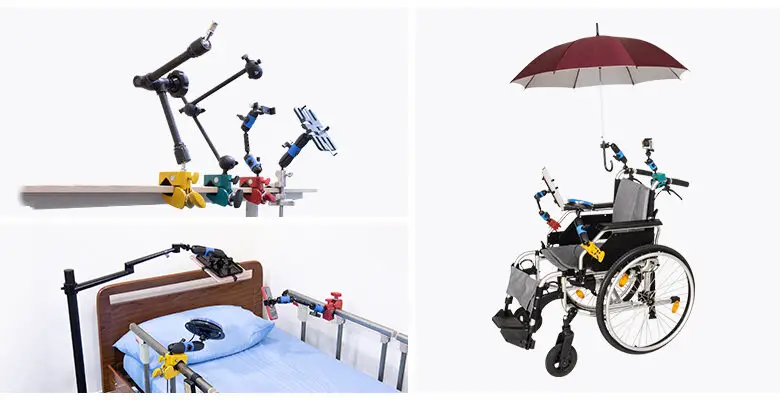
KUPOCARE: designing innovative and reliable mounting kits for people with disabilities
KUPOCARE is a company based in Taiwan that designs innovative, reliable and accessible mounting kits for disabled people to attach to their wheelchairs, tables or beds. Launched by entrepreneur Lyra Chang in April 2022, it has more than 70 mounting kits that can be used to hold electronic devices and other everyday objects.
Here, Lyra shares how she got into the assistive technology industry, how she founded KUPOCARE and how beneficial the mounting device stands could be to your life.
Can you tell us about yourself and your background?
I studied Life Science (Biology) at Tzu Chi University because I’ve always loved animals and science. After college, I joined the Biotechnology Master programme at the National Tsing Hua University.
My research was related to developing a protein-based vaccine against SARS-CoV-1. That’s back in the days of the first SARS outbreak in Asia (around 2004).
After obtaining my Master’s degree, I wanted to learn more about drug discovery and chemistry. Therefore, I joined the Chemical Biology PhD programme at the University of Michigan-Ann Arbor.
My PhD research focused on using a high throughput screen to discover small molecule modulators against Hsp70, which is an important chaperone protein that helps cellular protein fold to its correct conformation.
Protein misfolding is the root cause of many neurodegenerative diseases such as Alzheimer’s disease, Huntington’s disease and Mad cow disease.
Small molecule modulators of Hsp70 have the potential of relieving these protein misfolding diseases.
After getting my PhD, I continued doing various scientific work as a researcher for several years. I really enjoyed scientific research and the colleagues I worked with. However, I found that it was quite hard to balance work and family as a woman researcher, especially with kids.
In 2020, the pandemic hit and my parents asked me if I would be interested in joining KUPO Co. Ltd – a company they founded 40 years ago in Taiwan (my parents are getting old and I am the only child they have).
It was a hard decision for me because I really loved research and the science community, yet pursuing an academic career as a mother of two kids is quite unrealistic for me. In the end, I decided to leave the US and went back to Taiwan to join my parent’s company KUPO.
Can you tell us the background behind your parent’s company KUPO?
My parents founded KUPO Co. Ltd. They both studied International Trading in college and they were college classmates.
When my parents were young, Taiwan was in an economic booming stage and almost everyone wanted to start their own business and my Dad was no exception.
About the time I was born, my Dad quit his stable banking job and decided to build his own business. There were lots of ups and downs in my parent’s journey that many small business owners experienced. It wasn’t easy and I witnessed first-hand all the obstacles they had to face on the way.

They started by selling home appliances and then gradually moved into the entertainment industry by manufacturing and selling mounting hardware for lighting and cameras.
I am impressed that my parents always have a high standard for product quality and put a lot of emphasis on building good research and design teams.
What was your research process when coming up with the idea of KUPOCARE?
Given my biomedical research background, after I joined KUPO Co. Ltd, I wanted to explore whether KUPO’s products could be used in research labs or used to improve people’s wellbeing.
Even though I had to leave my beloved scientific research to join KUPO, I wanted to see if KUPO’s products can also bring positive impacts to people’s lives in areas other than the entertainment business.
To investigate the possibilities of using our products in the field of assistive technology, I brought our products (arms and base and cell phone/tablet holders) to the Assistive Technology for Life (ATLife 2021) Expo.
There were many people with disabilities visiting the Expo because it is the biggest product show related to assistive technology in Taiwan.
During the Expo, I randomly approached about 20 people with disabilities to show them our mounting products and asked them what kinds of items they want to mount onto their wheelchairs.
Through this little market research, I realised that people with disabilities have a great unmet need for mounting various devices on their wheelchairs. Also, during these short interviews, I made several friends who helped us a lot in KUPOCARE product development.
Next, I wanted to systematically go through/test all our KUPO Grip products to identify products that can be used in the assistive tech field. We started by forming an internal team – Brian Su, Kenneth (Ken) Chang and me.
Brian is a Research and Development Personnel (RD) and Ken is a sales representative who is very knowledgeable about KUPO Grip products.
In KUPO Grip’s catalogue, we have more than 1,000 products. We split the KUPO catalogue into three parts and we each were responsible for identifying products that can be used as mounting products for people with disabilities.
We collaborated with a couple of people with disabilities – Bo Chen who has cerebral palsy and Bo’a mum Jessica, and Mason who has a spinal cord injury. I met them during my market research at ATLife 2021.
We also got a lot of useful feedback from experts in the Icebreaker Project, Taiwan Motor Neuron Disease Association and The First Social Welfare Foundation.
You now have 70+ easy-to-use kits that can mount a variety of electronic devices and everyday items. Can you give us details on what is in your collection, how they work and how they benefit disabled people?
All of our mounting kits consist of a base, an arm and a holder (for devices or other objects).
KUPOCARE clamps
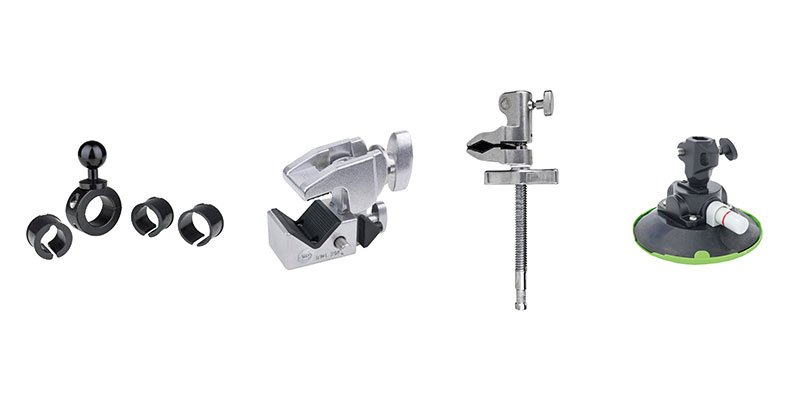
We have plenty of different clamps/bases in our parent company’s catalogues, but we selected four major bases after extensive tests. Having a very stable base is crucial for the success of any mounting solution.
The wheelchair tube clamp with its many plastic inserts can hold very stably onto wheelchair tubes with 19mm, 22.2mm, 25.4mm, 28.6mm and 32mm diameters.
It is the best clamp among all we’ve tested to provide an extra stable base for mounting phones, tablets, cameras and switches on wheelchair tubes. The good thing about it is that it wouldn’t spin on a wheelchair tube under force (super stable).
Another clamp we have is called Super Convi Clamp, it can securely hold onto tables between 5 and 30mm thick. The clamp is very sturdy and is TUV certified having a load capacity of 20kg.
We also have the Thick Table Clamp for thicker tables, which can hold onto tables up to 10cm thick.
Finally, we have the Magic Suction Cup, which is good for temporarily mounting items on nonporous glass surfaces.
KUPOCARE arms
We have three major types of adjustable arms: Super Knuckle Arms, Max Arm and Articulated Arm.
The Super Knuckle Arm has two sockets for receiving a ball head joint on each end. The ball head on either end of the arm allows users to freely adjust the arm’s angle and can be locked into position by tightening the central knob.
The users can easily switch ball heads by loosening up the central knob to remove or install ball head joints to the end sockets.
Our company has a huge collection of different ball heads that can be inserted into the arm to provide different functions.
The arms can also easily connect with all four bases we offer. We have three different lengths of Super Knuckle Arms – Small (3”), Medium (6”) and Dual Knuckle (9”). The load capacity of each Super Knuckle Arm is 5kg (3”), 3kg (6”) and 2kg (9”).
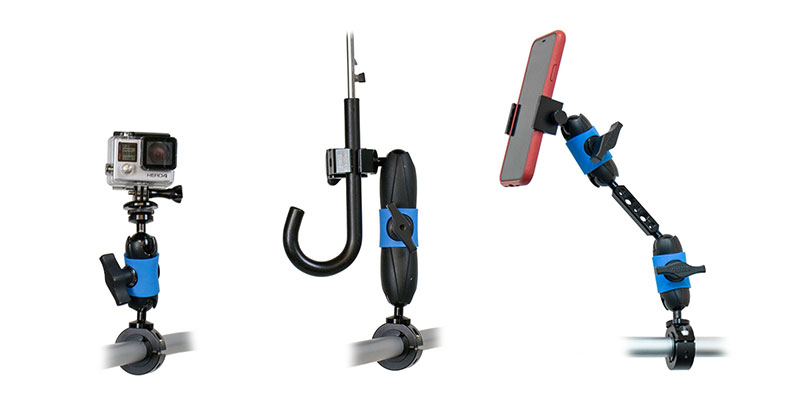
The Max Arm can extend to 20 inches (53cm). The ball head stud on each end is controlled by the large central knob. Loosening of the central knob allows easy adjustment to the optimal angle for the mounted device and tightening of the central knob can lock the whole arm at the adjusted position.
The centre joint has special friction discs with anti-slip rosettes to prevent unwanted movement. The Max Arm has 16mm hex pins on each side that can connect with Super Convi Clamp and Thick Table Clamp.
The Articulated Arm can extend to 22.5 inches (57cm) and has three 360-degree joints that allow you to easily adjust the position and angle of mounted devices. The joints are equipped with tooth patterns at the centre to provide solid locking mechanisms.
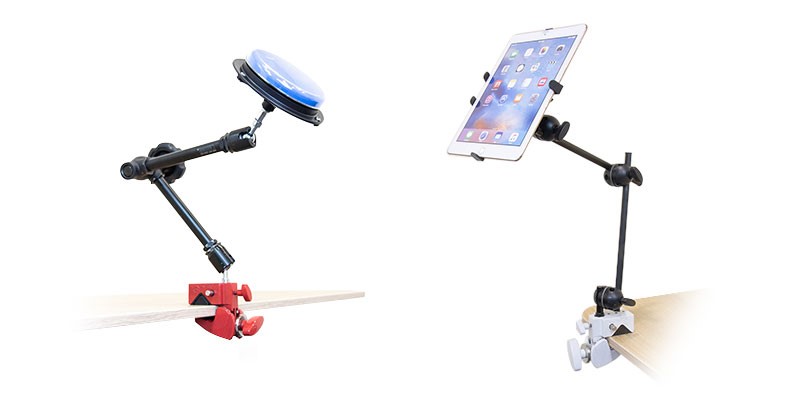
The 16mm hex studs on the end of the Articulated Arm can be connected to the Super Convi Clamp and Thick Table Clamp.
KUPOCARE holders
We have device holders for mobile phones, tablets, AAC devices, laptops, cameras, GoPros, switches and umbrellas.
We offer three different AAC Switch Mounting Plates that fit the hole patterns at the bottom of many AbleNet and Pretorian switches and joysticks. We are also developing holder plates for the new Microsoft Adaptive Switches and Joysticks.
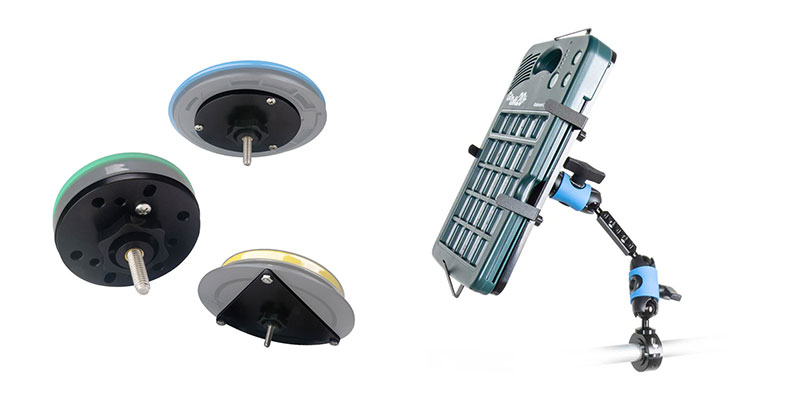
Our AAC device holders can hold thicker devices such as GoTalk devices (Attainment) and Quicktalker devices (AbleNet).
Another interesting holder we have is the Umbrella Holder. It can connect with the Super Knuckle Arm via its ball head and can hold tightly to any tube-shaped items with a diameter of 13 to 35mm, such as umbrellas, flashlights, microphones, flags and selfie sticks. It can be used as an extra hand to hold things for people with limited mobility.
***
Check out Rebecca Sullivan’s video product review of the Umbrella Holder:
KUPOCARE Gas-Spring Floor Stands
Other products we manufacture include Gas-spring Floor Stands designed for mounting larger devices such as monitors, heavier AAC devices or laptops.
We also provide gas-spring floor stands that have a load capacity of 10kg. The base has four wheels for ease of movement and the minimal base height (8cm) makes it very easy to slide the floor stand underneath a sofa, bed or other furniture.
The stand can extend from 110cm to 179cm (in height) and can raise the mounted items slowly once loosen the knob controlling the gas-spring mechanism.
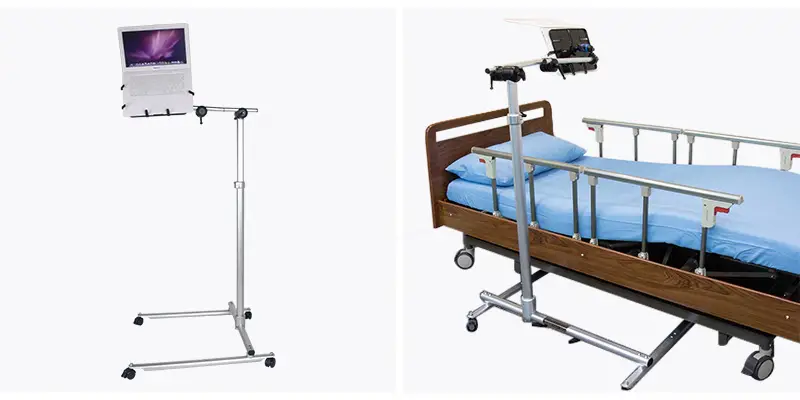
The gas spring in the floor stand provides additional protection for the user – the device wouldn’t fall down on the user when adjusting the height.
KUPOCARE Modular Wheelchair Mounting System
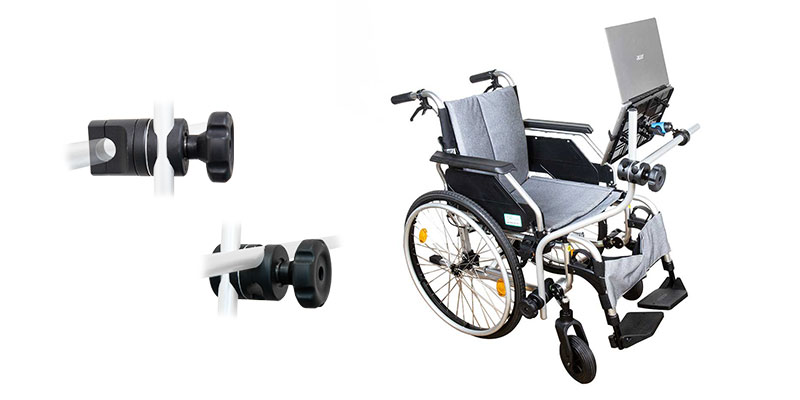
These Modular Wheelchair Mounting Systems are designed for mounting heavier devices on a wheelchair. We provide base clamps, joints and tubes (straight and S-shaped) for anyone to create optimal configurations for mounting any device.
Our wheelchair tube clamp is compatible with the 22mm tubes used in the mounting system and can be used to mount phones, tablets, laptops…etc.
We are also developing a modular mounting system that uses 16mm tubes for mounting lighter objects.
What are the advantages of KUPOCARE products?
I believe there are four advantages for disabled people using our products:
1. Reliable: our products were originally designed for mounting equipment such as lighting and cameras. Therefore, they are built to be very sturdy to stably mount various devices.
2. Easy to mix and match: our products have unified connection mechanisms – either through 16mm pins or via ball heads. Therefore, they can function like Lego and it is very easy to customise mounting solutions for each user.
3. Innovative: KUPOCARE represents a rapidly growing product line and we are willing to accept suggestions and requests from our customers to develop new and better mounting products for people with disabilities.
4. Some of the novel products in our parent company KUPO can be applied to the assistive technology (AT) field, which brings more innovative power to our products.
Did you have any challenges along the way in starting your business?
Yes. In the beginning stage, we needed to do a lot of hands-on testing and brainstorming to find out the best configurations that could mount various items stably on wheelchairs, beds and tables.
We also had to think differently when designing mounting products for people with disabilities because we needed to emphasise more on safety and usability.
I think all those challenges made the development process more interesting and engaging. We learned a lot from the feedback of our collaborators and brainstorming with them gave us new ideas for product development.
At present, how do you make, sell and distribute your products?
Our parent company KUPO Co. Ltd. has a very strong RD team expertise in designing mounting products and we also have our own factory in China.

Whenever we have ideas for a new product, our RD will design the prototype and our factory will make the sample. After testing the samples ourselves and with our collaborators, they will be mass-produced by our factory.
For our entertainment side of the business (KUPO Grip), we have many distributors globally.
For the newly developed KUPOCARE products, now we have a distributor in Japan (Techno Tools) and this year we are seeking distributors for KUPOCARE products in UK, US, and Canada.
Have you got any new products lined up for the future?
Yes. We are interested in developing mounting solutions for adaptive gaming. We believe that making gaming more accessible is a way to help people with disabilities build more social connections – playing together is a great way to build friendships.
We are currently partnering with Ablegamers to create mounting boards and stands for gaming devices such as switches, joysticks and Microsoft Adaptive Controllers.
In the future, we might also investigate if we can make other kinds of games/sports more accessible to people with disabilities as well.
What advice would you give to other entrepreneurs?
Don’t be afraid to explore new business ideas and learn from your customers and collaborators.
You can find out more and purchase mounting kits by visiting the KUPOCARE website and follow KUPOCARE on Twitter and YouTube.
By Lyra Chang at KUPOCARE
More on Disability Horizons…